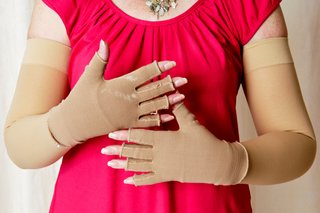Lymphoedema is a long-term (chronic) condition that causes swelling in the body's tissues. It can affect any part of the body, but usually develops in the arms or legs.
It develops when the lymphatic system does not work properly. The lymphatic system is a network of channels and glands throughout the body that helps fight infection and remove excess fluid.
It's important that lymphoedema is identified and treated as soon as possible. If it is not treated, it can get worse.
Symptoms of lymphoedema
The main symptom of lymphoedema is swelling in all or part of a limb or another part of the body. It can be difficult to fit into clothes, and jewellery and watches can feel tight.
At first, the swelling may come and go. It may get worse during the day and go down overnight. Without treatment, it will usually become more severe and persistent.
Other symptoms in an affected body part can include:
- an aching, heavy feeling
- difficulty with movement
- repeated skin infections
- hard, tight skin
- folds developing in the skin
- wart-like growths developing on the skin
- fluid leaking through the skin
What causes lymphoedema?
Lymphoedema is caused by a problem with the lymphatic system, a network of vessels and glands spread throughout the body. The main functions of the lymphatic system are helping fight infection and draining excess fluid from tissues.
There are 2 main types of lymphoedema:
- primary lymphoedema – caused by faulty genes that affect the development of the lymphatic system; it can develop at any age, but usually starts during infancy, adolescence, or early adulthood
- secondary lymphoedema – caused by damage to the lymphatic system or problems with the movement and drainage of fluid in the lymphatic system; it can be the result of a cancer treatment, an infection, injury, inflammation of the limb, or a lack of limb movement
Who's affected
Lymphoedema is thought to affect more than 200,000 people in the UK. Primary lymphoedema is rare and is thought to affect around 1 in every 6,000 people. Secondary lymphoedema is much more common.
Secondary lymphoedema affects around 2 in 10 people with breast cancer, and 5 in 10 people with vulval cancer. About 3 in every 10 people with penile cancer get lymphoedema.
People who have treatment for melanoma in the lymph nodes in the groin can also get lymphoedema.
Your treatment team will let you know if you're at risk of getting lymphoedema from your cancer or cancer treatment. Any planned treatment you have will try to avoid causing damage to your lymph nodes.
Cancer Research UK has more information about lymphoedema and cancer.
Diagnosing lymphoedema
See a GP if you experience the typical symptoms of lymphoedema, such as swelling in your arms and legs. They may refer you to a specialist lymphoedema treatment centre for further assessment.
In many cases, lymphoedema can be diagnosed from your symptoms and medical history, and by examining the affected body part and measuring the distance around it to see if it's enlarged.
Occasionally, further tests may be necessary to assess and monitor your condition.
Treating lymphoedema
There's no cure for lymphoedema, but it's usually possible to control the main symptoms using techniques to minimise fluid build-up and stimulate the flow of fluid through the lymphatic system.
These include wearing compression garments, taking good care of your skin, moving and exercising regularly, having a healthy diet and lifestyle, and using specialised massage techniques.
Read more about treating lymphoedema and preventing lymphoedema.
Complications
Cellulitis is the most common complication of lymphoedema. It can also have a significant psychological impact. It can be serious if it's not treated quickly.
Cellulitis
If you have lymphoedema, the build-up of fluid in your tissues makes you more vulnerable to infection.
Cellulitis is a bacterial infection of the deep layer of skin (dermis) that often affects people with lymphoedema. Cellulitis can also sometimes cause lymphoedema.
Symptoms of cellulitis can include:
- redness and a feeling of heat in the skin
- pain and increased swelling in the affected area
- a high temperature
- chills
Antibiotics taken by mouth (orally) can usually be used to treat cellulitis, although severe cases may need to be treated in hospital with antibiotics given directly into a vein (intravenously).
Psychological impact
Living with a long-term condition that affects your appearance can cause a great deal of distress and lead to periods of depression.
You may be depressed if you've been feeling down for the past few months and no longer find pleasure in things you usually enjoy.
If this is the case, talk to a GP or a member of your lymphoedema treatment team. Effective treatments are available for depression.
Talking to other people with lymphoedema can be reassuring and decrease feelings of isolation, stress and anxiety.
The Lymphoedema Support Network provides information and advice, and can put you in touch with a support group in your area.
If you persevere with your treatment plan, your symptoms should eventually become less noticeable.
Media review due: 23 December 2020
Page last reviewed: 25 November 2019
Next review due: 25 November 2022

